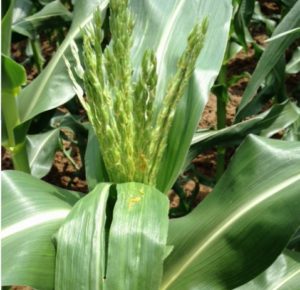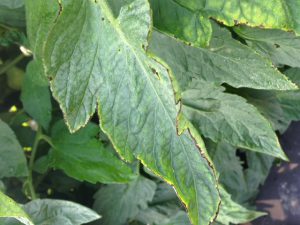Sweet Corn
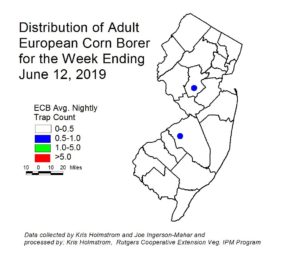 European corn borer (ECB) moths catches have declined to nearly nothing over the past week (see map at left). Feeding percentages have increased, and should peak over the next 5-7 days. As of the weekend, feeding percentages as high as 24% in Cape May and 60% were found in whorl corn in Somerset County, but these numbers seem to be outliers. The majority of feeding is in the 2-14% range throughout much of the state.
European corn borer (ECB) moths catches have declined to nearly nothing over the past week (see map at left). Feeding percentages have increased, and should peak over the next 5-7 days. As of the weekend, feeding percentages as high as 24% in Cape May and 60% were found in whorl corn in Somerset County, but these numbers seem to be outliers. The majority of feeding is in the 2-14% range throughout much of the state.
Growers should scout whorl and pre-tassel stage plantings weekly. Look for the characteristic “shot-hole” type of feeding (photo below at right) and consider treating when infested plants exceed 12% in a 50 plant sample. As plantings proceed to the pre-tassel stage, ECB larvae may be found in emerging tassels (see photo at left). It is a good idea to treat individual plantings as they move into the full tassel/first silk stage one time. This eliminates any ECB larvae that have emerged with the tassels as they begin to move down the stalk to re-enter near developing ears.
Useful insecticides for this particular application include synthetic 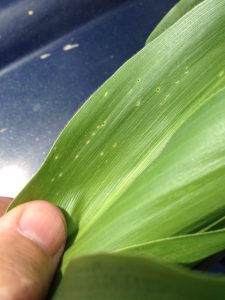 pyrethroids (IRAC Grp 3), spinosyns (including OMRI approved Entrust) IRAC Grp 5), and diamides such as Coragen (IRAC Grp 28) or materials such as Besiege which include the active ingredient in Coragen. Synthetic pyrethroids alone should NOT be used for corn earworm (CEW) protection on silking corn. Control with these materials is very inconsistent.
pyrethroids (IRAC Grp 3), spinosyns (including OMRI approved Entrust) IRAC Grp 5), and diamides such as Coragen (IRAC Grp 28) or materials such as Besiege which include the active ingredient in Coragen. Synthetic pyrethroids alone should NOT be used for corn earworm (CEW) protection on silking corn. Control with these materials is very inconsistent.
The highest nightly trap catches of ECB for the week ending 6/12/19 are as follows:
| Califon 1 | Milford 1 |
| Hillsborough 1 | Pedricktown 1 |
| Medford 1 | South Branch 1 |
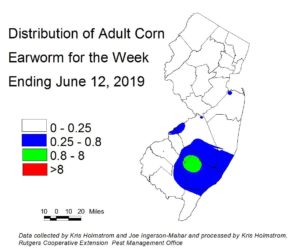 Low level corn earworm (CEW) moth catches continue in southern central NJ blacklight traps through early this week (see blacklight map at left). Early plantings, now silking, are at risk of infestation from this pest.
Low level corn earworm (CEW) moth catches continue in southern central NJ blacklight traps through early this week (see blacklight map at left). Early plantings, now silking, are at risk of infestation from this pest.
IPM personnel have now nearly completed deployment of a statewide network of pheromone traps for CEW. There are far fewer CEW pheromone traps than blacklights, and the resulting map has much broader color bands as a result. It should also be noted that the pheromone traps are much more sensitive than blacklights. Therefore, the number of moths caught in pheromone traps required to generate a specific spray interval is much higher than the number caught in blacklight traps. As of this week, pheromone trap catches vary widely, with much higher numbers in the south, and very low activity in northern NJ (see pheromone map below at right).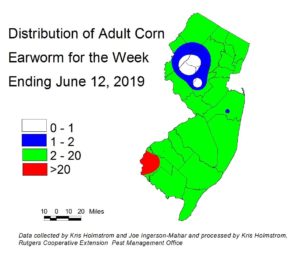 The green area on the pheromone trap map indicates a 4-5 day silk spray schedule. It must be stressed that there is high variability in these catches, and growers should consult with their IPM practitioner on recommended spray schedules.
The green area on the pheromone trap map indicates a 4-5 day silk spray schedule. It must be stressed that there is high variability in these catches, and growers should consult with their IPM practitioner on recommended spray schedules.
The highest nightly trap catches of CEW pheromone trap catches for the week ending 6/12/19 are as follows:
| Woodstown 48 | Elm 15 | Eldora 9 | Jobstown 6 |
| Crosswicks 20 | Monroeville 14 | Green Creek 7 | Berlin 5 |
| Pedricktown 19 | Cedarville 12 | Beckett 6 | East Vineland 5 |
Silking Spray Schedules*:
South – 4-5 days
Central – 4-5 days
North – 6 days
*These recommendations are based on regional catches. Adhere to tighter spray schedules if indicated by local trap catches.
Tomatoes
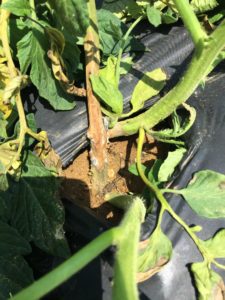 Timber rot (Sclerotinia) (photo at left) continues to appear, and our weather remains conducive to its’ development. This fungal disease is favored by wet conditions and cool temperatures. Spores infect t
Timber rot (Sclerotinia) (photo at left) continues to appear, and our weather remains conducive to its’ development. This fungal disease is favored by wet conditions and cool temperatures. Spores infect t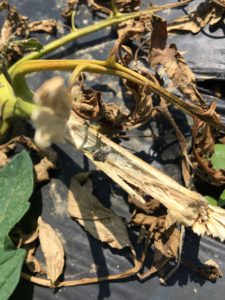 he main stems of the plants, causing them to wilt, with the stems turning dry and brittle. Closer inspection of these lesions will show the black sclerotia (photo at right), as are characteristic of this disease. These pellet-like masses of fungal tissue will drop to the ground as the plant deteriorates, and will serve as inoculum for the following season. For this reason, infected plants should be removed from the field or high tunnel. Sclerotinia can infect tomatoes, peppers, beans, lettuce and brassica crops.
he main stems of the plants, causing them to wilt, with the stems turning dry and brittle. Closer inspection of these lesions will show the black sclerotia (photo at right), as are characteristic of this disease. These pellet-like masses of fungal tissue will drop to the ground as the plant deteriorates, and will serve as inoculum for the following season. For this reason, infected plants should be removed from the field or high tunnel. Sclerotinia can infect tomatoes, peppers, beans, lettuce and brassica crops.
Bacterial leaf spot infections (see photo at left) have begun to appear in some fields following heavy rains. Look for very dark lesions on leaf margins, and on the interior of immature leaves. Lesions will have chlorotic borders and may cause immature leaves not to expand properly. Growers should treat preventively for this disease prior to symptoms. See the tomato section of the 2019 Commercial Vegetable Recommendations Guide for materials and spray schedules.
Peppers
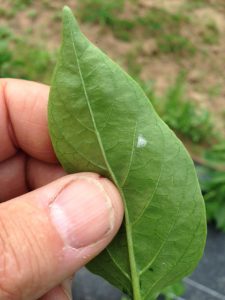 With declining ECB moth activity, growers should be looking for ECB egg masses (see photo at left) on the underside of pepper leaves. The larvae that hatch from these eggs will bore into the central stem of pepper plants in the absence of suitable fruit. This damage causes the tops of the plant to die, and eliminating the crown set of fruit in the process. Check 2 leaves per plant on 5 consecutive plants in 10 random locations. Consider treating if 2 or more leaves are found to have ECB larvae on the lower surface.
With declining ECB moth activity, growers should be looking for ECB egg masses (see photo at left) on the underside of pepper leaves. The larvae that hatch from these eggs will bore into the central stem of pepper plants in the absence of suitable fruit. This damage causes the tops of the plant to die, and eliminating the crown set of fruit in the process. Check 2 leaves per plant on 5 consecutive plants in 10 random locations. Consider treating if 2 or more leaves are found to have ECB larvae on the lower surface.
Pumpkins and Winter Squash
With pumpkin and related crop fields now being planted, it is important to remember that the initial threat will be from striped cucumber beetles. Most seeds now come with a pre-applied insecticide to limit injury from this pest. However, growers should be alert to the possibility that untreated seeds may be fed upon heavily by cucumber beetles, resulting in bacterial wilt in a few weeks, or outright death of seedlings from excessive feeding. Scout 5 plants each in 10 random locations. If beetles are found to be feeding at more than two sites, consider an insecticide application to limit damage. It is unlikely that this situation will occur if seeds were pre-treated.
A cucurbit downy mildew sentinel plot was established at Snyder Farm in Hunterdon County last week. This plot, consisting of pumpkin, watermelon, cantaloupe, butternut, acorn, cucumber and kabocha squash will be used to indicate the presence of cucurbit downy mildew in the region, and what crops are affected. For regional information on this important disease, see the Cucurbit Downy Mildew Forecast webpage: http://cdm.ipmpipe.org/.
